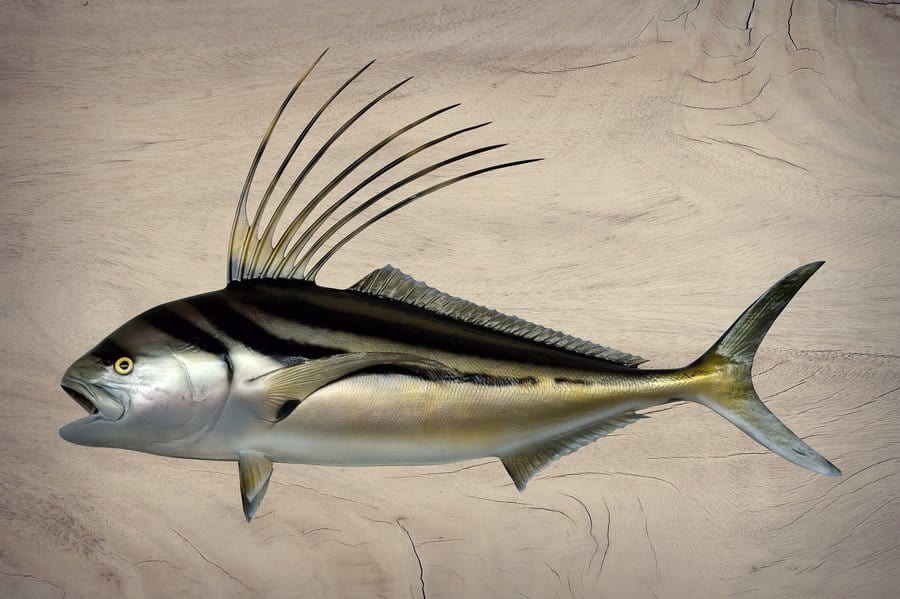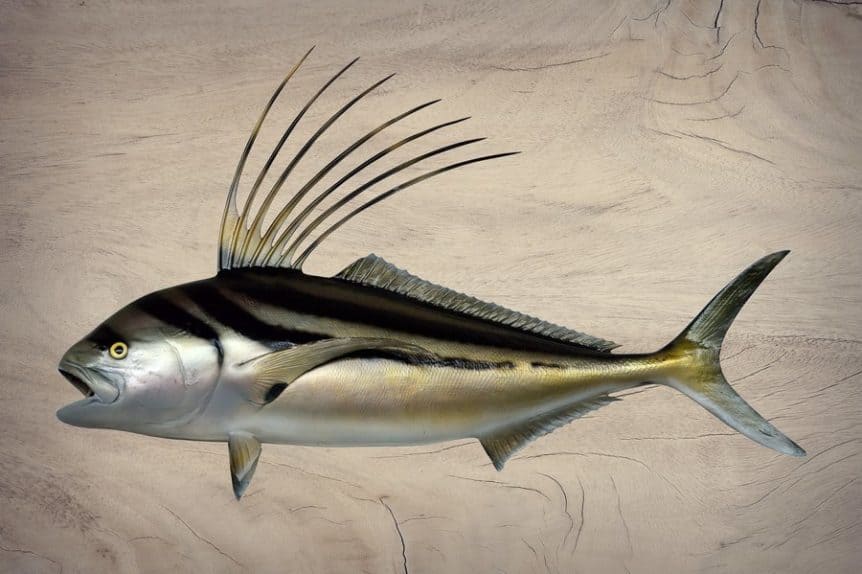
Picture this: you’re standing on a charter boat off Costa Rica’s Pacific coast, the sun glinting off the waves, and your line suddenly goes taut. A roosterfish, with its iconic comb-like dorsal fin slicing through the water, is putting up the fight of a lifetime.
This is why anglers from around the globe flock to Costa Rica, chasing the thrill of hooking one of the ocean’s toughest inshore game fish. In this guide, we’ll dive into everything you need to know about roosterfish fishing in Costa Rica, from the best spots and techniques to planning your trip with a top-notch charter. Let’s get started!
Why Roosterfish Are the Ultimate Catch
Roosterfish, scientifically known as Nematistius pectoralis, are the rockstars of inshore fishing along Costa Rica’s Pacific coast. Part of the jack family, they’re built for battle, with a streamlined body, zebra-like stripes, and that unmistakable dorsal fin resembling a rooster’s comb. These fish are pure muscle, averaging 15 to 20 pounds, though 40-pounders are common, and monsters over 80 pounds have been landed in Costa Rican waters. Their aggressive nature and relentless runs make them a favorite among sport anglers, whether you’re a seasoned pro or a first-timer. While edible, roosterfish aren’t prized for their taste, which is why catch-and-release is the norm here, preserving the population for future adventures.
Where to Find Roosterfish in Costa Rica
Costa Rica’s Pacific coastline is a roosterfish paradise, with volcanic rock outcrops, surf zones, and river mouths serving as prime hunting grounds. These fish love structure—think rocky reefs, sandy bottoms, and areas where baitfish congregate. Fortunately, you can chase them year-round, though the dry season (December to April) often brings clearer waters and more active fish. Below, we highlight some of the top spots to target these bruisers, each offering unique opportunities for anglers.
Bat Islands: A Northern Gem
Near the Nicaraguan border, the Bat Islands are a hotspot for roosterfish, reachable from ports north of Flamingo. This group of islands teems with roosters, as well as snapper and wahoo, making it a diverse fishing destination. The rugged terrain and nutrient-rich waters attract trophy-sized fish, so come prepared for a fight.
Catalina Islands: Accessible and Productive
A short run from Flamingo, the Catalina Islands are a convenient choice for anglers staying in the Guanacaste region. While they may not boast the same numbers as the Bat Islands, the Catalinas have produced plenty of respectable roosterfish catches. Pair your trip with a chance to hook jacks or mackerel for a well-rounded day on the water.
Matapalo Rock: Trophy Territory
At the northern entrance to Golfo Dulce, Matapalo Rock is a legendary spot for giant roosterfish. Anglers here often return with stories of epic battles against roosters, cubera snapper, grouper, and even the occasional mako shark that leaps skyward after taking a bait. The deep waters and diverse structure make this a must-visit for serious anglers.
Quepos: Central Pacific Hotspot
The rock piles near Manuel Antonio and the river mouths between Quepos and Dominical are roosterfish magnets. This stretch of the Central Pacific coast also yields jacks, snapper, mackerel, and big black snook, offering plenty of action. Quepos is a great base for anglers looking to combine fishing with vibrant coastal culture.
Drakes Bay: Remote and Rewarding
For those willing to venture off the beaten path, Drakes Bay on the Osa Peninsula is a prime destination. The endless structure along the coastline and the reef inside Caño Island create ideal conditions for roosterfish. With fewer boats and less fishing pressure, especially from August to November, this area delivers some of the best trophy fishing in Costa Rica.
Top Techniques for Catching Roosterfish
Roosterfish are as cunning as they are strong, so you’ll need the right approach to outsmart them. Live bait is the gold standard, with feisty blue runners or hearty small mullet producing the most consistent results. Free-lining these baits without weight allows for a natural presentation—just give the fish a second or two after the strike before setting the hook to ensure a solid connection. Trolling with Rapala lures or slow-trolling belly baits on skirts can also work, though it often attracts smaller roosters in the 15- to 20-pound range.
For fly anglers, roosterfish present a thrilling challenge. The process is often a test of patience: a blue runner is free-lined without a hook to draw the roosterfish close to the boat, then a fly is presented. These intelligent fish frequently snub flies, but when they do strike, the battle is unforgettable, with scorching runs and acrobatic displays. Popular flies include big, bushy patterns like green or blue deceivers, cast on 10- or 11-weight rods with sinking lines.
Topwater lures, such as Yo-Zuri bull poppers or Halco Roosta poppers, are another exciting option, mimicking the erratic movement of baitfish like sardines or bonito. Casting these lures in turbulent waters near reefs or rocky headlands can trigger heart-pounding surface strikes. Whatever method you choose, sturdy gear is essential—a medium-heavy action rod paired with a 5000-series spinning reel and 40-pound braided line will help you handle the roosterfish’s powerful runs.
Conservation and Catch-and-Release
In Costa Rica, roosterfish are a protected species, and sustainable fishing practices are a priority. All roosterfish must be released after a quick photo, using circle hooks to minimize injury and handling them with wet hands or a towel to protect their slime coat. Keep the fish out of the water for no more than 15 to 20 seconds, and revive it gently before release to ensure it swims away strong. These practices help maintain healthy roosterfish populations, ensuring future generations can experience the thrill of the chase.
Planning Your Roosterfish Fishing Trip
A successful roosterfish trip hinges on choosing the right charter. Costa Rica’s fishing industry is booming, but not all boats are created equal. Look for charters with a proven track record, experienced captains, and crews who know the local waters like the back of their hands. Longව
| Location | Charter Name | Highlights |
|---|---|---|
| Quepos | Jackpot Sportfishing | Specializes in inshore trips targeting roosterfish, with expert guides. |
| Osa Peninsula | Crocodile Bay Resort | Access to prime spots like Matapalo Rock and Caño Island. |
| Guanacaste | Capullo Sportfishing | Focuses on secret roosterfish spots off the northern coast. |
| Los Sueños | Los Sueños Fishing Charters | Year-round roosterfish trips with modern boats and gear. |
Before booking, check reviews on platforms like TripAdvisor or FishingBooker, and ask locals or fellow anglers for recommendations. Charters like Jackpot Sportfishing in Quepos or Crocodile Bay Resort on the Osa Peninsula have built solid reputations over years of delivering epic fishing experiences. Expect to pay $500 to $1,900 for a half- or full-day trip, depending on the boat size and inclusions like meals or transportation. Booking during the dry season (December to April) can offer better weather, but roosters are catchable year-round, so don’t let timing hold you back.
Tips for a Trip of a Lifetime
Beyond the fishing, Costa Rica’s Pura Vida lifestyle adds to the adventure. Pair your trip with a visit to a volcanic hot spring, a jungle tour, or a taste of local seafood like ceviche. Pack sunscreen, a hat, and polarized sunglasses to cut through the ocean glare, and bring a waterproof bag for your camera to capture that trophy shot. If you’re new to roosterfish fishing, consider hiring a guide who can teach you the ropes and maximize your chances of success. Most importantly, embrace the unpredictability of the chase—every cast is a chance to hook a memory that’ll last a lifetime.
Ready to Reel in a Roosterfish?
Fishing for roosterfish in Costa Rica is more than a sport—it’s an adventure that combines adrenaline, natural beauty, and the thrill of the unknown. Whether you’re casting from the surf at Drakes Bay or trolling near Matapalo Rock, the Pacific coast offers endless opportunities to battle these inshore giants. With the right charter, gear, and a bit of patience, you’ll be telling stories of your roosterfish conquest for years to come. So, what are you waiting for? Book your trip, pack your rod, and get ready to experience Costa Rica’s ultimate fishing challenge!

